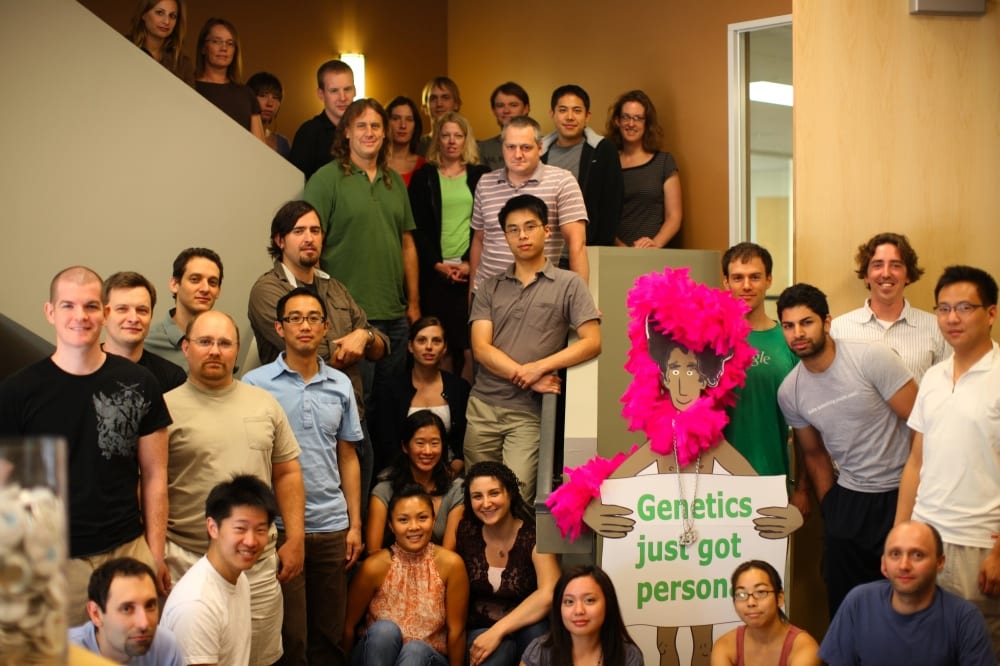
Editor’s Note: This week TIME Magazine is naming the 23andMe Personal Genome Service, its Invention of the Year, an honor that the publication has previously bestowed on innovations such as the iPhone and YouTube. This post by Director of Products Alex Wong (back row, second from right) offers a glimpse at how 23andMe came to be, and what makes it such a powerful tool for exploring your DNA.
We’re thrilled that our product has been named TIME Magazine’s 2008 Invention of the Year. But what exactly did we invent? To answer that question, let’s to go back to the early days of 23andMe … .
I first met our co-founders Anne and Linda, together with Serge and Brian, our first two employees, in the summer of 2006 at a bakery in downtown Palo Alto, Calif.. As they were explaining the basic concept behind the company, Linda reached into her bag and pulled out a CD with “Aveys” written on it in magic marker.
“What’s that?”, I asked.
Her reply: “It’s my family’s genomes!”
That’s a first, I thought to myself – pulling genomes from a handbag. I was hooked. I knew I wanted to join 23andMe and help make this possible for everyone and their family.
But we had a long way to go. DNA chip technology was still fairly new, something that only researchers had access to. Linda, having worked at a DNA chip company, was able to get her own family genotyped. But unless you had an in at a research lab or one of these companies, getting your own genome just was not possible. Even if you did manage to get the genomes of you and yours on a CD, all you’d find when you looked at it would be a bunch of giant, indecipherable text files filled with “rs” numbers and A’s and B’s. These are the raw data files of SNP information that the DNA chip analysis produces.
How to make sense of all that data? The good news was that years of research, starting with the Human Genome Project and the International HapMap Project, had produced a wealth of publicly available information about human genetics. The bad news was, it was all locked inside databases designed by researchers, for researchers. Want to know what one of your SNPs means? A logical place to start, you would think, would be dbSNP, a massive database of SNPs run by the National Institutes of Health.
Good luck. Assuming you can wade through its dense user interface, make sure you get your alignment, genome build, major and minor alleles, orientation, and stranding right, or you’re liable to get your interpretation backwards and think you’re supposed to have wet earwax when you really have dry! Don’t know what stranding, genome builds, or any of those other things are? Trust me, you’d rather not.
Not only did these government and academic databases sport slow and unfriendly user interfaces, but some of them also had data quality and consistency problems and few of them were linked together.
So it was going to require more than just building a website to make all the fruits of ongoing genetic research accessible, useful, and compelling to regular people like you and me. We had to create a whole architecture and process for cleaning up, aggregating and integrating all of this human genetic information, combining it with an individual’s own genotype data, running comparisons and algorithms on it, blending it with great educational content, and serving it back to our customers through a friendly user interface – all in under 500 milliseconds, which is how long you have before people start to complain that your website is slow.
On top of that, we wanted personal genetics to be social, so our customers could see their genetic data in context and learn about what makes us all different and similar at the same time. That meant building in the ability for customers to share their data with family or friends without sacrificing privacy or security.
It’s taken the combined talents of all the different kinds of people we have at our company, from bioinformaticians, to engineers, to writers, to UI designers, but we’re all so excited about having made it possible in 2008 for anyone with $399 to explore their own genome.
Of course, if you’d like to rock it 2006-style, you can still get your own gigantic text file full of SNPs using our Download Your Raw Data feature. You can even burn it onto a CD and stick it in your handbag!



